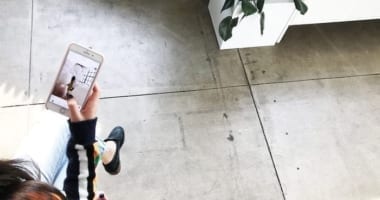That was the question at the heart of a recent roundtable for Artsy gallery partners. Hosted at our London office, the panel of experts included journalists, marketers, and PR specialists. We also followed up with panelists Josh Rivers, Marketing Manager at Gay Times Magazine, and Sophie da Gama Campos, Pelham Communications, to learn more about their press advice for gallerists and their experience with the art world online.
Speaking on how the digital landscape is changing gallery relationships with media, they have specific steps galleries can take to stand out online—whether pitching an idea to a journalist or promoting an article to a new audience.

Left: Josh Rivers; Right: Sophie da Gama Campos
What was most memorable about the Artsy for Galleries event and what you heard from gallerists?
Josh Rivers: It was an understanding that we’re all looking for great ways to spread and talk about our ideas. Whether that’s gallerists looking for the most appropriate platform to promote their artists or magazines like Gay Times looking for new ways to speak to their audience. I got a distinct feeling of curiosity and it felt like a great way to start a problem-solving project for both sides.
Sophie da Gama Campos: It was interesting to hear how so many small teams and young galleries are already taking such a creative approach to exhibition programming as well as the content side of creating stories around artists and projects. Lots of galleries at the event were already making rich media content for Instagram or thinking creatively about studio photography and artist portraits. Having strong content is the first step in creating a successful PR campaign so it was really good to see galleries already doing that.
What sets apart a “good” pitch to a publication from a “bad” pitch?
SdGC: I think you really have to understand the publication you’re pitching to start with. Journalists are getting hundreds of emails a day, so keep your pitch clear and concise. We usually write a short paragraph that explains who the artist is or what the gallery is about including the key facts they need to know like when it’s happening and what they may expect to see. Include a few images so the writer can get a sense of that artist and what their work looks like. Also, attach a press release so that if your pitch sparks their interest they can open it to learn more.
The minimum material that you need to pitch in the first instance is the artist name, the dates of exhibition, where it’s taking place and a few images such as past works or studio shots for works in process. For lots of press, unless they’re critics, exactly what’s going to be in the show is often not their sole focus, but rather they’re developing stories around an exhibition that can be personality driven and profiles the artist. Don’t let it hold you back that you don’t have every single piece of information confirmed about an exhibition.
What’s the most common mistake galleries make in their pitch?
JR: Not making it personal to the publication they’re pitching to. It sounds like a lot that you would take a personal approach to meeting someone or to reaching out to them. But you have a client to promote and you need to get in touch with someone.
With anybody or any brand, I can’t imagine reaching out to someone without first looking them up on LinkedIn or looking up their website, looking up their Twitter account. I always go through people to get to people and find that by doing so, I have a much better success rate. It’s very easy for someone to find out what I’m interested in.
When is the best time to submit a pitch?
SdGC: That is where the majority of people go wrong: not being aware of press timelines and the fact that lots of press are working with incredibly long lead times. Consumer magazines like Vogue or Harper’s Bazaar are commissioning 5-6 months in advance, so ideally that’s when you would go to them with a project. Art publications are often working 3-4 months in advance. For online press and weekly magazines, you can secure coverage pitching a month to a couple of weeks in advance of their publication date. But by the time the show opens, you’ve missed your moment really.
We suggest coming up with a target press list of who you really want to reach for the exhibition of publications that fit that artist of exhibition. Think about their lead times and pitching them in that order. Increasingly, publications want content exclusively and once you’ve negotiated those exclusives the rest of your pitching can work around that.
JR: Be flexible. At Gay Times, we have a digital magazine, a print magazine, we have our website and our social media channels. There is more than one way to get your artist the attention they deserve. Be really open—at Gay Times we’re thinking about video, Instagram takeovers, and Facebook Live interviews. We’re looking at lots of different ways in which to capture content and reach our audience, and to give your artists another platform to draw attention to their great work.
One surprising takeaway from the event was the emphasis on printed collateral—invites, programs, postcards—as an effective way for galleries to stand out with journalists. What else can galleries do to attract attention?
SdGC: If a gallery can afford to invest in strong printed collateral then that’s great, but obviously there’s a cost associated with printing and postage and I wouldn’t say it’s essential. What’s more important is that what you’re sending out (digital or printed) is well-designed and reflects your brand.
Your online presence is just as important as your offline one. It provides an opportunity to reach very targeted audiences and the art world is so global—you’re not just trying to speak to audiences in your country or your city, and there are a whole range of people who will be interested in your project but will never be able to step into the gallery. Having a strong digital presence allows you to speak to those people in some way.
JR: What I would really love to see, what would get my attention is an email first and foremost from a gallerist or gallery: “Hey, I heard you’re interested in X. Do you want to grab a coffee or can I come and show you what we’re working on?” I’m very much a people person and that’s the best way to get my attention. If I think of all the things I show up to, I show up because I know the person personally or it has been recommended by a friend. We respond to relationships.
Once a pitch turns into an article, what is the best way to promote it?
SdGC: The first thing to do is promote it on social media. When you do, make sure you’re tagging the publication as well as the writer. If it’s someone who has taken the time to write an article, they may want to see you’re promoting them as well as the publication. It means you’re engaging with those people on social media so if they weren’t already following you they might, and it’s a way to increase followers. Making sure that not just the gallery but also the artist is posting it and asking if the publication to post it on their social channels—it’s something you can usually agree upon if you’re giving a lot of the content to one publication.
In the past decade, there’s been an overwhelming shift from printed publications to online media. Do you expect to see a similar shift play out in the art world?
SdGC: That’s already happened really. The audiences that you can reach through online are just vast compared to print when you start looking at circulation figures of publications. Arts pages are being cut in print publications around the world, and a lot of content to do with arts coverage is moving online now.
JR: As long as galleries can surprise and delight people, I don’t see why they wouldn’t still attract people. I think art can never forget its place in helping the world see itself differently. Art has so much to offer and amazing platforms like Artsy help democratize art.
At Gay Times we’re using our online platforms not only to amplify the content within our own magazine, but using those as different platforms to amplify different content which might reach a different audience and tell a different story. It allows us a diversity of thought and experience that we haven’t heretofore been able to have and are only harnessing right now. And I think art is no exception to that—the discovery of art online is really revolutionary and so exciting
Josh Rivers is Marketing Manager at Gay Times Magazine—the longest running magazine for gay and bi men. Gay Times includes a print publication, digital magazine, and multiple social media accounts that make up the world’s largest online audience of any LGBT publication. In addition to overseeing all marketing channels for the publication, Josh also spearheads brand partnerships for the publication, which most recently includes a collaboration with Penguin Random House to recognize queer creatives.
Sophie da Gama Campos is a Director at Pelham Communications, a global visual arts communications agency with locations in London and New York. Sophie works with galleries, art fairs, museums, and foundations to develop and reach new audiences through media relations, digital strategy, events, and branding.



